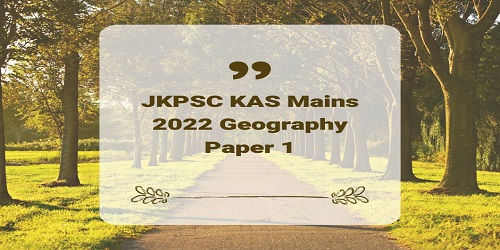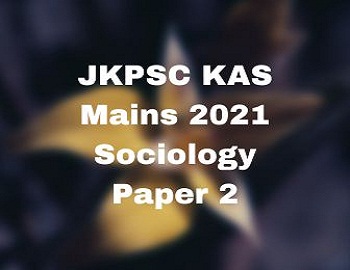JKPSC KAS Mains 2022 Geography Paper 1:
INSTRUCTIONS
Please read each of the following instructions carefully before attempting the paper.
(i) There are eight questions divided in two Sections and printed in English. Candidate has to attempt Five questions in All. Questions No. 1 and 5 are compulsory and out of the remaining, any Three are to be attempted choosing at least One question from each Section. The number of marks carried by a Question/Part is indicated against it. Answers must be written in English in Question-Cum-Answer (QCA) Booklet in the space provided.
(ii) Your answer should be precise and coherent.
(iii) If you encounter any typographical error, please read it as it appears in the text book.
(iv) Candidates are in their own interest advised to go through the general instructions on the back side of the title page of the Answer Script for strict adherence.
(v) No continuation sheets shall be provided to any candidate under any circumstances.
(vi) No blank page be left in between answer to various questions.
SECTION- A
1. Answer the following questions in about 150 words each: (5 x 10 = 50)
(a) Describe the role of plate tectonics in mountain building. (10)
(b) Explain the impact of El Nino in bringing global weather changes. (10)
(c) Discuss the role of physical and human factors in vulnerability of Joshimath to land subsidence. (10)
(d) Contemporary problem of coral bleaching is consequence of global warming. Elaborate. (10)
(e) Biodiversity is key to sustainability. Elaborate. (10)
2. (a) Describe the interior structure of the earth and highlight the role of seismic waves in understanding earth’s interior. (20)
(b) Discuss the advantages and limitations of social forestry. (15)
(c) Explain how organisms of an ecosystem are linked together. (15)
3. (a) Explain how climate change has enhanced flood vulnerability in south Asia. (20)
(b) Landscape is a function of structure, process, and stage. Elaborate. (15)
(c) Discuss the potentials and limitations of marine resources and threats there to. (15)
4. (a) Describe why urgent action to combat climate change and its impacts should be global priority and how it is impacting our farms and food. (20)
(b) Explain the basic elements of the Environmental Management System. (15)
(c) Discuss the origin and characteristics of tropical cyclones. What is the energy potential of a tropical cyclone? (15)
SECTION- B
5. (a) Discuss the merits and demerits of quantitative revolution in human geography. (10)
(b) Why China is “The World’s Factory”?
(c) Evaluate the role of growth poles and growth centres as a strategy for balanced regional development. (10)
(d) Critically examine the role of satellite towns in urban planning. (10)
(e) Discuss the strategy and role of SEZs in international trade. (10)
6. (a) Critically evaluate Weber’s industrial location theory. (20)
(b) Describe the geopolitics of heartland region in the context of Russia-Ukraine war. (15)
(c) Explain global human development pattern on the basis of the human development index (HDI). (15)
7. (a) Why is there such a thing as world hunger? What are the ways to solve this issue? (20)
(b) Discuss the challenges and ways for sustainable urbanisation. (15)
(c) Describe the different types of regions and methods of regionalisation. (15)
8. (a) Highlight the factors contributing in mushrooming of slums in the third world cities. What is their social impact? (20)
(b) Explain why environmental issues have gained prominence in regional planning. (15)
(c) Describe the variations in demographic transition in more developed and less developed countries. (15)









Comments (No)